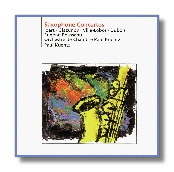
The Internet's Premier Classical Music Source
Related Links
-
Bennett Reviews
Dubois Reviews
Debussy Reviews
Glazunov Reviews
Heath Reviews
Ibert Reviews
Villa-Lôbos Reviews - Latest Reviews
- More Reviews
-
By Composer
-
Collections
DVD & Blu-ray
Books
Concert Reviews
Articles/Interviews
Software
Audio
Search Amazon
Recommended Links
Site News
 CD Review
CD Review
Works for Saxophone & Orchestra

- Alexander Glazunov: Saxophone Concerto
- Claude Debussy: Rapsodie
- Heitor Villa-Lôbos: Fantasia
- Jacques Ibert: Concertino da camera
- Richard Rodney Bennett: Saxophone Concerto
- Ted Heath: Out of the Cool
John Harle, saxophone
Academy of St. Martin-in-the-Fields/Neville Marriner
EMI Classics 72109


- Alexander Glazunov: Saxophone Concerto
- Heitor Villa-Lôbos: Fantasia
- Jacques Ibert: Concertino da camera
- Pierre Max Dubois: Concerto for Alto Saxophone and String Orchestra
Eugène Rousseau, saxophone
Orchestre de Chambre Paul Kuentz/Paul Kuentz
Musical Heritage Society MHS 5148352 or
Deutsche Grammophon 453991-2
These two recent releases are not only both entitled Saxophone Concertos, but they have three pieces in common (as well as additional unique works). What can this mean? That a poltergeist of musical coincidence is lurking among us? That interest in classical saxophone works is growing? That the repertoire for classical saxophone works so is small and that they're so short, they can fit on one CD?

I'll ignore this intriguing overlap and try not to recommend one collection over the other. The performances are so different from one another, so varied in interpretation and engineering, that you may want to evaluate each on its own strengths and limitations.
Eugène Rousseau's rendition of Ibert's whimsical Concertino da Camera is hot and frenetic, his saxophone taunting, sometimes almost shrill. John Harle's is cooler, his saxophone mellow, sometimes muted, and its Larghetto is lazier and less mannered than Rousseau's. (He smoothes away most of its vibrato.) Both performers play the piece skillfully, but there are twenty-six years of interpretative license separating them. Harle's cadenza in the Animato molto produces notes higher than I've ever heard from a tenor saxophone. Rousseau plays the same sequence with competence but no undue risk. He plays the Villa-Lôbos Fantasia and the Glazunov Saxophone Concerto with a light touch, even some wit. From Harle we get more of a sense of national authenticity in these works, particularly with the Villa-Lôbos. He plays the Très animé without exaggerating the native rhythms, an unfortunate trait in Rousseau's style. Rousseau plays it like a showcase piece, possibly the way 1972 Europeans came to expect Brazilian music to be performed. However, he does an excellent job on the Glazunov, with its prancing, sexy, sly rhythms. Harle plays Debussy's Rapsodie enchantingly, limning its dreaminess and exoticism.
Neither performer can redeem the mediocre pieces on these collections, such as Ted Heath's Out of the Cool (Harle) and Pierre Max Dubois' Concerto for Alto Saxophone and String Orchestra (Rousseau). Dubois' Concerto is jazzy without being jazz; it's just not smoky enough. Heath, while composing nifty saxophone solos, doesn't seem to know what to do with the orchestra. It feels intrusive, out of place, borderline hokey.
The sound engineering on the Harle emphasizes subtle tone colors while the re-released Rousseau is brash and in-your-face. If you play them consecutively, be prepared to adjust the volume for the second.
Copyright © 1999, Peter Bates




















